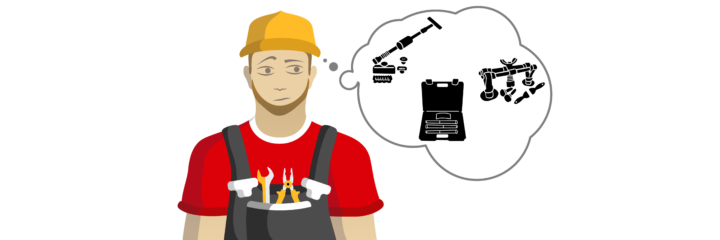There are people out there who like it when their cars look beat up. Gambler racers, 24 hours of LeMons, your weird uncle who calls it “derelict style.” Most people don’t and would prefer their car to remain undented. Dents are an inescapable part of life, however. It’s a good thing that a bunch of companies make excellent products to unbend your car.
- Tapping Out the Dent Repair Kit Basics
- Top 10 Best Dent Repair Kits 2025
- 1. Best PDR Kit Overall: Gliston Auto Dent Puller Kit
- 2. Best Premium PDR Kit: Anyyion 69pc PDR Kit
- 3. Best Bridge-Style PDR Kit: Manelord Auto Body Repair Tool
- 4. Best Hammer and Dolly Set: Neiko 20709A
- 5. Best Budget PDR Kit: Yoohe 22pc
- 6. Best Versatile PDR Kit: AUTOPDR 48pc
- 7. Best T-Bar Puller Kit: Manelord T-Bar with Upgrade Tabs
- 8. Best Inexpensive Complete PDR Kit: ARISD 32pc
- 9. Best Advanced Dent Removal Rod Kit: Mookis Rod Set
- 10. Best Cheap Suction Cup: ABN Dent Puller
- All About Paintless Dent Removal
- Get Shaping
Tapping Out the Dent Repair Kit Basics
Traditionally, dent repair uses welders, grinders, and men with masks to cut out the offending panels and replace them. Fortunately, the modern era has brought us a ton of options for the home DIYer. Most of the options won’t even hurt your paint.
If you already know what you’re doing, you can jump straight ahead to our product list to find what you need.
PDR
PDR stands for paintless dent repair. That’s because you don’t have to repaint your car after you use the tools. There are two ways to do a paintless dent repair.
Push on the Dent From Behind
Take a tool, get it behind the dent, and pound the dent out. If you can get the piece of bodywork off the car, then hammers like the Neiko set on the list work great.
If you can’t, long thin tools like the Mookis are your answer. They can get in and behind dents. Then you either beat on the rods with a hammer or pry against things to give you a mechanical advantage.
Compared to the pulling tools, they take way more experience and practice to use right. You can use them to make any shape you want, which makes the training worth it if you are serious about doing a lot of bodywork.
Pull the Dent Out From the Face
The second style of dent removal comes in the form of pulling on the dent. Modern glues are fantastic. To grip the dent, so to speak, you glue studs to the surface.
You can also use a suction up. In traditional dent removal, you would weld studs onto the surface or drill holes to set anchors where you destroy the paint. Unless you really have a nasty dent, you don’t need to destroy the paint.
Kinds of Pullers
When you get a dent kit, it will come with some kind of tool for pulling on the dent out. There are four main types.
T-Bar or Slide Hammer
A T-bar or other style of slide hammer is used to apply a lot of force in a quick, sharp motion. When you slide the weight up the handle, it strikes a stop that jerks the tool away from whatever it’s attached to. It takes some practice to use right, but it can offer a lot more fine control and doesn’t require the amount of space that other tools need. The T-bar also doubles as a handle for pulling with good old manual force.
Bridge Type Puller
A bridge puller has two or more feet attached to stand-offs and holds a bolt suspended over your dent. It bridges the gap over the dent, hence the name. You glue the pad to the dent, attach it to the bolt, then start unscrewing the bolt. As it rises through the device, it will pull the dent out. These are very simple and intuitive; they just take a while to set up.
Squeeze Style
These tools go by many names, but basically, they have two arms that you squeeze together to pull up on the glued tab. You get more leverage than just pulling by hand, and it’s faster than a bridge-style puller.
Suction Cup
Suction cup style tools are the most basic, least effective tools on the market. They only work on dents that are a certain shape, and they will never have the control or versatility that other types have. They are ridiculously cheap though, so it doesn’t hurt to try them out.
What’s in the Box?
Kits never include absolutely everything. Even Ikea expects you to have a small hammer, so when you look for a PDR kit, you know that something is going to be missing.
The most complete kit on our list is the Anyyion – but they sell a kit that is even bigger and includes multiple sizes of hammer. It’s gigantic, yet it still doesn’t include a Phillips screwdriver for adjusting the puller tension.
The point is that you will have to choose what tools you are willing to source elsewhere. If the kit doesn’t include a glue gun, you will need to provide your own. If it doesn’t come with a slide hammer, you will have to decide if you need one or not.
Is It Easy to Use?
Let’s face it, the whole point of buying a kit is to make the dent disappear as easy as possible. Different types of tools are inherently more straightforward than others. Bridge type tools are easier to use than body hammers, but the easier it is to use, the less versatile it is. You won’t be able to fix as many types and kinds of dents with easier to use kits.
There are all sorts of kits that span the entire quality and price spectrum. One of the nice things about the kits on this list is that even the lower quality ones have a lot of value, so you can’t go wrong. If you get a kit that doesn’t do exactly what you want, it’s easy to simply add a few things here and there and make it perfect.
Top 10 Best Dent Repair Kits 2025
1. Best PDR Kit Overall: Gliston Auto Dent Puller Kit
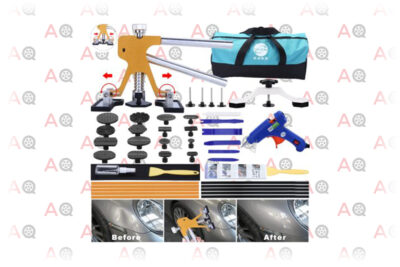
Editor’s Rating:
What You Get
Inside the box is everything you need to get straight to work, minus a few small hand tools. You get the glue gun, a squeeze type puller, a variety of pads, a hammer, glue, scrapers, and a few small punches.
You also get a cheap, nearly useless bridge tool that you probably won’t use. It’s not as complete as a monster kit like the Anyyion, but it doesn’t lack anything you need.
Our only suggestion is to pick up some better scraping tools, like these plastic chisels. The good news is that any extras will fit in the generous canvas bag they include with the kit.
How Easy Is It to Use?
We are confident anyone could get good results from this kit. The squeeze type “Golden Dent Remover” is about as easy to use as they come. Unless you need to do a lot of shaping, it is as easy as glue and squeeze. Just remember to work slowly; these types of dent pullers work best in small areas. It’ll work out big dents, but only if you do it a little at a time.
Our Thoughts
There are more complete kits, like the Anyyion, and there are less expensive kits, like the Arisd, but none have the value that Gliston brings. That value comes in two forms.
First, the quality is good. The tool is metal and well built, the tabs are thick and not likely to fail, and the glue gun melts glue. That’s honestly all you can ever really ask from a hot glue gun. The second thing that gives it value is the fact that it includes enough stuff in the kit to just get right into pulling dents.
We do have a few things to nitpick. We always do; being an expert nitpicker is in the job description, so don’t go thinking there’s something badly wrong just because we criticize it. The instructions that Gliston includes are garbage. Get online and watch other people use it on forums or youtube, and throw away the paper it comes with.
Also, the kit is complete, but it could really use a better scraper. Oh, and the bridge tool is not the best. That’s fine, honestly. Just use the Golden Lifter instead and get a Manelord bridge tool if you really need one.
Pros
- Amazing value
- Includes everything you need
- Dent puller is super easy to use
Cons
- Included instructions are garbage
- It would be nice if they had better scrapers

Editor’s Rating:
What You Get
Everything. Or rather, everything but a bridge puller. That’s fine because you get a squeeze puller and a slide hammer. Those tools, along with the massive selection of tabs, will cover any dent that can be fixed by a puller. The glue gun is good, the hammer and sets are good, and you get a toolbox to store it all in.
How Easy Is It to Use?
It may seem like the most challenging part of using this kit is choosing how to tackle the problem. There’s a lot of options, and knowing which method for which dent does take a lot of work. The truth is that the hardest part is getting familiar with the T-bar. The whole kit just takes more thinking and practice than the Gliston or Manelord bridge kit.
Our Thoughts
Excuse us for a minute while we talk about something incredibly boring. Keeping organized, especially when you have a set of tools with many tiny parts, is hard. It will ruin your whole day if you go to grab a tool and it’s missing a single nib that you need right now. The fact that Anyyion includes a nice toolbox to store their entire kit in says a lot about their product: they get it. They make sure there’s no excuse for not staying organized.
The big ouch moment comes when you see the price because it’s twice as much as everything else on the list. That can make it hard to justify. The AUTOPDR kit also has a case and a cheap bridge tool. It’s half the price and will work fine once or twice. If you need higher quality, especially if you plan on doing a lot of bodywork, you won’t be disappointed with this kit despite the cost.
Pros
- Includes everything you need
- Comes in a carrying case
- Tools are high quality
Cons
- Expensive
- Not as easy to use as other kits
3. Best Bridge-Style PDR Kit: Manelord Auto Body Repair Tool
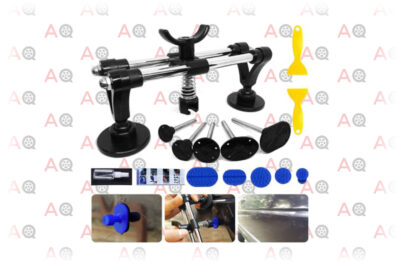
Editor’s Rating:
What You Get
You get a bridge tool and some tabs. That leaves you to source your own glue gun and glue, which is not ideal. The bridge tool is the best on our list, though. It’s well built and is more comfortable to use than other bridge tools, like the one included in our budget pick Yoohe kit.
How Easy Is It to Use?
Bridge tools are super easy to use already, but Manelord makes it even easier by designing a bridge tool with quick-connect tabs. The only reason it’s not the easiest thing to use on our list is because of the fact that you have to source your own glue and a glue gun. That can be tough; if you get the wrong glue, you won’t get the most out of the tool.
Our Thoughts
The Manelord bridge tool is high quality, easy to use, and relatively inexpensive. It really demonstrates the best reasons to get bridge tools over other tools. There are better tools for big dents, but none are as easy to use or as inexpensive.
The fact it is so good at being a bridge tool also means that it also exemplifies the downsides of bridge tools. It takes forever to use compared to other tools, for one thing. It also isn’t good for spanning larger dents. If you have large dents, get a slide hammer kit like the Manelord one we recommend here. It’s not a coincidence that you see the brand Manelord a lot on our list. They make great quality bodywork tools.
Pros
- High Quality
- Well designed
- Inexpensive
Cons
- Does not include a glue gun. They do sell a kit with one, but it’s rarely in stock.
- It’s not good for big dents
4. Best Hammer and Dolly Set: Neiko 20709A
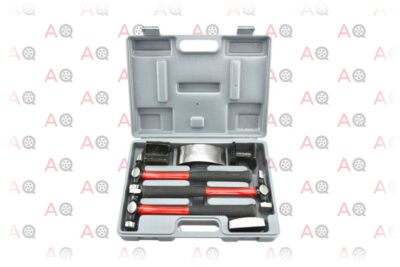
Editor’s Rating:
What You Get
A hammer is used to pound the metal against a shaped anvil looking thing called a dolly. The hammers have different shapes, so you can use them to stretch or dimple the metal in different ways. The dollies are curved to allow you to bend the metal into different shapes. This kit has 4 dollies and 3 hammers for a total of 8 dolly shapes and 6 hammer shapes. That should keep you busy.
How Easy Is It to Use?
The Neiko hammer set is not easy to use. Other than the fact that a hammer works like a hammer and everyone knows how to use one, there is nothing intuitive or straightforward about shaping metal. It takes practice, patience, and a willingness to mess up horribly for a while.
That being said, if you are serious about dent removal and are willing to take the time to learn, you can do anything with this set. For instance, tab pullers can’t do anything for a crease. A hammer can work it out, no problem.
Our Thoughts
The Neiko kit includes everything you need to get started in autobody work. In a case too, which is nice. Just don’t make the mistake of thinking that you will buy this and suddenly be the next Foose. It takes time to build up the skills to shape metal.
It’s also important to note that this is a good starter set, not professional tools. It’s cheap and works fine, but the quality is nowhere near acceptable for a full body shop.
You’ll also want to pair it with some dent removal rods. You don’t have to splurge on the Mookis rods we recommend; as there are plenty of cheaper ones that work ok. They are essential for working on the metal you can’t reach, though.
Pros
- The set gives you a good amount of shaping options
- Inexpensive
- Comes in a carrying case
Cons
- Not easy to use at all
- Quality could be better
5. Best Budget PDR Kit: Yoohe 22pc
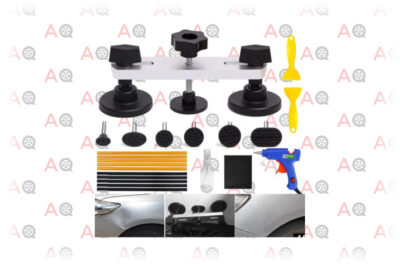
Editor’s Rating:
What You Get
The kit includes a bridge tool, glue, glue gun, and some pads. That’s a pretty spartan kit compared to others, but it’s honestly all you need. If you already have a glue gun, save $5 and get a bridge kit without it. Although, $5 for a hot glue gun is a pretty good deal, so you might as well grab it.
How Easy Is It to Use?
It’s hard to find an easier kit, honestly. One of the biggest advantages of a bridge style tool over one of the squeeze tools is how intuitive they are to use. The main part of the device is a big screw. If you handed it to a toddler, they would figure out how to operate it. Except for the glue gun. Don’t give toddlers hot glue guns.
The downside is that it takes a long time. A squeeze tool is just like, click, and squeeze. A bridge tool is all like “turn, turn, turn, turn, dangit my wrist is tired.”
Our Thoughts
We’ll head off the first issue right out of the gate. There is a suction cup tool here that is way cheaper. So why is this our budget pick?
It’s because this kit is a complete kit, one, and it will actually work for a variety of dents, two. A suction cup device is cheap because it doesn’t work very well. You get what you pay for, as it were.
Speaking of which, we have another bridge style kit on our list here. That one is higher quality, easier to use, and not much more expensive. If you just want to test the waters, the Yoohe is fine. Just don’t expect Snap-On quality from Harbor Freight prices.
Pros
- Complete kit with glue gun
- Very easy to use
- Inexpensive
Cons
- Quality could be better
- Takes a while to get dents out
6. Best Versatile PDR Kit: AUTOPDR 48pc
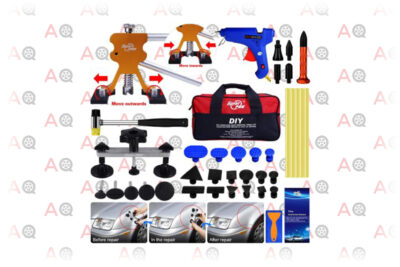
Editor’s Rating:
What You Get
You get a punch, a glue gun, tons of tab shapes, a hammer, a bridge-style puller, and a squeeze style puller in the kit. That’s pretty much the entire range of tools in the PDR department. The only thing you might be left wondering about is where is the slide hammer.
If you really need a slide hammer, though, it’s not that this kit is missing it. It’s just that you should buy a different kit more suited for larger dents like the Anyyion above.
How Easy Is It to Use?
You honestly couldn’t ask for better. It has both the incredibly intuitive bridge puller and the clamp and squeeze type of puller. Like with the Gliston, you could stand to get a better scraper to make your life a little easier. This kit comes in a case, though, so not only is it easy to use, it’s easy to clean up.
Our Thoughts
We love it when tools come with their own case. We love it when PDR kits come with the glue gun. We love being able to choose between the ant jaw clamping squeezy tool and the traditional bridge puller. There’s just a lot to love when it comes to AUTOPDR’s offering.
The direct comparison for the AUTOPDR kit is the Gliston, and, unfortunately, that’s when our love runs out. It’s just not nearly as high quality, and it’s only a little cheaper. The bridge tool is better in the AUTOPDR kit, so if that’s important to you, then definitely go with this one. If you can get together another $10, though, the Gliston will last longer and be a little less frustrating.
Pros
- It’s a very complete kit
- The bridge tool is better than the Gliston kit’s
- Very easy to use
Cons
- The general quality isn’t very high
- Not very good for large dents
7. Best T-Bar Puller Kit: Manelord T-Bar with Upgrade Tabs

Editor’s Rating:
What You Get
Inside this kit, you get a T-bar and some tabs to pull on with it. You don’t get an easy to use pulling tool, you don’t get glue or a glue gun, and you certainly don’t get a case to carry it around in. If you need a T-bar and want to make sure it includes some extras, it’s perfect. If you want the whole kit, the much more expensive Anyyion is up top.
How Easy Is It to Use?
Using a T-bar or any slide hammer takes some practice. It’s nowhere near as simple as using a bridge tool or a squeeze tool. It’s a lot more versatile, though. Slide hammers can be used in places where there is no other surface to pry against. That means, unlike bridge or squeeze tools, you can use them on large dents and work very quickly. Usually, you’ll want to glue on a lot of tabs ahead of time. You move the tool around a lot from tab to tab and slowly pull out a huge area.
Our Thoughts
Let us just come right out and say it, if you are serious about dent repair, you need a T-bar. They aren’t easy to use, and they aren’t as cool as one of the alien mandible-looking doohickies, but they work on areas where everything else won’t.
We do wish it had a glue gun and glue in the kit. It just makes things a lot nicer when you don’t have to source the glue. That being said, this isn’t really a beginner kit. This kit is more for someone that already has a beginner kit and wants to up their game, and in that regard, it’s fantastic.
Like, if you bought the Gliston and found a dent that’s just a little bigger than you want to tackle with the Gold Puller, pick up this one here. It’s still a little cheaper to do it that way than to buy the Anyyion kit that includes one. Plus, you can build your kit over time instead of relying on a random company to do it for you.
Pros
- Great tool for tackling large dents
- Includes high-quality pull tabs
- Makes a great addition to other kits
Cons
- Takes some time to learn to use
- Doesn’t include glue
8. Best Inexpensive Complete PDR Kit: ARISD 32pc
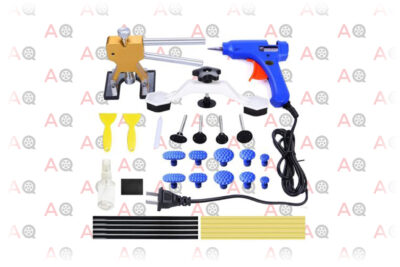
Editor’s Rating:
What You Get
The box contains an inexpensive puller, glue gun, bridge tool, and a handful of bits and pieces. It’s not as complete as anything else, really, even the AUTOPDR kit is more comprehensive. It does include everything you need to just jump in and do it though.
How Easy Is It to Use?
The ARISD kit is very easy to use except one thing: you might not have the tool you want to use in the kit. Not a total deal-breaker or anything. It’s just that you might find yourself reaching for a hammer that isn’t there, unlike more complete, more expensive kits. That can lead to some hair pulling, which is never easy to deal with.
Our Thoughts
This kit is cheap. If you’re wanting to fix a few dents on your daily and don’t really care about getting a high-quality tool, it’s perfect. The quality will really let you down if you want to do a lot of dent repair. The bridge tool is pretty bad, the squeeze tool rattles, and the scrapers aren’t great.
It’s still a better thing to buy than a suction cup puller, despite what the internet might tell you. You will really get a good feel for whether or not pulling dents is something you want to do, or if you should take it to a shop instead. This is one of the few budget kits that include a squeeze style dent lifter. It’s not great quality, but it will definitely work well enough for a few small jobs.
Pros
- Inexpensive
- Includes a glue gun
- Generally easy to use
Cons
- Some common tools are not included
- Quality isn’t very high
9. Best Advanced Dent Removal Rod Kit: Mookis Rod Set
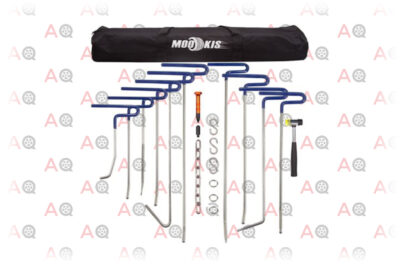
Editor’s Rating:
What You Get
In a rolled-up travel bag, you’ll find ten differently shaped rods. You also get a hammer, some chain that you can use as a leverage device, and a small punch. That may not seem like a lot, but it really is a ton of versatility and use from a small kit. Dent rods allow you to reach into an area that you wouldn’t otherwise be able to access and pound out a dent from behind. It’s not just the best tool for the job; it’s pretty much the only tool for the job.
How Easy Is It to Use?
Dent rods are not easy to use. The price of failure is not as high as it is with bodywork hammers, but it still takes a lot of practice to make them work for you. The big distinction between a hammer kit like the Neiko and a set of rods like this one is the amount of metal you shape per tap. A hammer moves a lot of material; if you strike it wrong, you can add a huge dent. Tapping on a rod only moves a bit of metal. It takes a long time to get a dent out, but if you miss it’s not a big deal.
Our Thoughts
These are expensive and hard to use. They have a gigantic learning curve. They are intimidating, and it is amazingly frustrating to work with a tool like this for hours and hours and see no results. Rod tools take a lot of time, no matter how you slice it. At least this kit is really, really good quality.
They are absolutely indispensable if you plan on making your car look the best it can. Sorry everyone that wants everything to just be cheap and easy, but pulling tools have their limitations. Don’t get us wrong, if you have some small dents, a tool kit like the Gliston is absolutely perfect. It will pop the dent, and you’ll be happy. For the few of you restoring a 69 Camaro and need to pop a crease out of the roof, though, you should pick up a set like this one.
Pros
- Amazing for detail work
- The best tool for reaching hard to reach areas
- Great quality
Cons
- Expensive
- Hard to use
10. Best Cheap Suction Cup: ABN Dent Puller
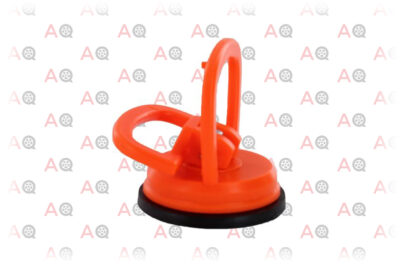
Editor’s Rating:
What You Get
A suction cup. That’s it. It’s just a suction cup in some clamshell packaging.
How Easy Is It to Use?
It’s really, really easy to use. You stick it to the dent and pull. That’s pretty much the end of it. The downside is that there are only a small range of dents that a suction cup puller works with. If you don’t have a dent that’s uniform, small, and in thin metal, then it doesn’t matter how easy it is to use in theory because it won’t work.
Our Thoughts
Here it is, the suction cup dent puller. It’s required to include one on any list discussing dent removal, and it’s the first thing that DIY car care people buy in hopes that it will work. We can’t stop you from getting one because it’s like a rite of passage. They are super cheap, and they all seem to have the same video of a really enthusiastic guy sporting a goatee happily pulling out a dent and showing the world how amazing and easy the suction cup puller is.
Then it arrives, you try it on your car, and 95% of you will come back and get the Gilston kit.
That’s because they just don’t work very well on most dents and dings. First, the dent has to be uniform so the suction cup can seal against it. Second, it has to be just a little bigger than the tool. Not too big or deep, you won’t have the strength to pull it out, and not too small, or you will pull on the metal around the dent instead of the dent.
This particular one from ABN is at least a good size. Most of the ones in discount stores are way too big to be useful for anything, but the ABN is only 2” in diameter. We know you’re curious about it and have the same morbid fascination with super cheap tools that we all do, so we won’t’ say anything when we see it sitting on your workbench collecting dust. Just maybe grab a bridge puller like this one too so that you don’t have to wait for it to ship.
Pros
- Cheap
- Good size
- Owning one makes you part of a worldwide club of people who know better but do it anyway.
Cons
- It only works in perfect conditions
- Even when it works other solutions will look better
All About Paintless Dent Removal
Buying the dent removal tool is actually the easiest part of the process. Removing dents is fairly tricky no matter which tool you choose to use. That’s not awesome, we’ll admit, but don’t worry. Read through this and you’ll do great.
Types of Dents
The first thing you have to know is how your car is dented. It’s just like how a doctor has to know what kind of disease the snotty child next door had before knowing what medicine to give you.
Round Dents and Small Dings
Ever seen a car get hit by a golf ball? That causes a round dent. Round dents are easily removed by most pulling type dent removers, like the Manelord bridge tool above. Smaller round dents rarely take more than a couple of pulls and are the only time you’ll see a suction cup device like the ABN shine.
The good news is round dents are the most common dents. In fact, according to the internet, shopping carts are the single worst thing for cars ever. Round dents are also caused by hail, a light tap from a car backing into you, or your buddy headbutting your car after a long night at the bar. All those can be solved with most PDR tools.
Sharp Dents
As we move into sharper dings and dents, we start to move away from the world of pulling tools. They can do an ok job on smaller areas, but you’ll get better results by learning to use a set of rods like this kit we talked about. When metal takes a sharp object to the surface, it has a high chance of distorting. That means you stop being able to just pop the dent out and start entering the world of shaping metal.
Creases
Fixing a crease dent is about the extent of a DIY kit. Even with a combination of high strength PDR tools like the Anyyion and body rods like in the Mookis kit, you will have difficulty getting a creased panel to look like new. If you can remove the panels and pound on them, you can use hammers like these on our list to re-shape the metal. At that point, you are leaving the realm of paintless repair and entering the realm of having to repaint.
Serious Damage
Once you get into serious damage, you leave the world of dent repair kits behind. You have options still. Some are good options, like cutting out the damage and rebuilding it or using welded studs to do some serious shaping. Some are bad options, like using gallons of Bondo. Regardless, severe damage is usually best left to shops that specialize in repair.
Paintless Dent Repair Tips and Tricks
Once you know the symptom and have bought the medicine, here’s some info to get you started on the right foot.
Watch Some YouTube Videos
For some reason, car YouTubers love to show off dent repair. Take advantage of that and watch a few; it will really get you prepared to do it yourself. The guys in this Eastwood video do a great job working through the process, but if you search for the type of tool you want to use and decide that, there’ll be a video catering for you too.
Work in Small Increments
Most of dent repair is about sneaking up on the issue and fixing it in small increments. When you use a bridge tool or other puller, it’s best to use small movements and do less. Slowly add more pulling and larger areas as you go.
Practice on Soda Cans
The final exam in bodyshop class makes you use a TIG welder to weld a new shaped panel onto an aluminum can that you cut out of a different can. You don’t have to get that crazy, but it’s a good idea to spend some time working soft metal into different shapes. Then you know what the tools you bought will do to your car.
Mind the Heat
If your car gets hot, the glue won’t set. If the glue doesn’t set, you have a bad time. Usually, just keeping your car out of the sun is enough to keep it cool.
Mind the Cold Too
The cold makes paint brittle, glue brittle, and hands brittle. Those are all widely considered bad things. Brittle paint can crack or be pulled off by the glue, which elements the whole paintless part of paintless dent removal. Use some strong lights pointed at the dent if you are working in a cold shop, that’s sufficient.
Don’t Expect Perfect Results Your First Time
In fact, don’t expect perfect results even if it’s the fourth or fifth time you are doing it. It takes a ton of time and skill to get really good at dent repair. What you can do is get good results that take the edge away from an ugly dent.
Get Shaping
Hopefully, after reading this, you feel inspired. You can get rid of that dent that’s been on your Camry for the last 3 years. You can finally get around to working the rash out of your project drift missile. You can remove the dent you put into your sister’s car that one time you crashed your bike into her door while showing off to your friends. Grab a kit and start gluing.
